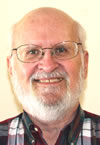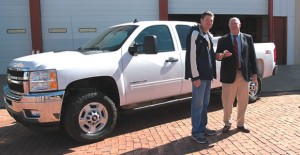
CISD freezes salaries, considers tax hike
By Roger Estlack, Clarendon Enterprise
An election to raise property taxes may be on the horizon following last Thursday’s regular meeting of the Clarendon ISD Board of Trustees.
Facing a projected budget deficit of $358,000, trustees acted on Superintendent Monty Hysinger’s recommendation and froze salaries for district employees and unofficially gave the administration the okay to pursue a timeframe for a June tax ratification election.
The election is just a proposal at this time; but if pursued and approved, Clarendon’s school taxes would increase 13 cents from the current state cap of $1.04 per $100 valuation to $1.17.
Hysinger told trustees the problem is twofold – state funding cuts and declining enrollment. School districts across Texas, including CISD, sued the state for unfair funding following the last legislative session, and a court has ruled in favor of the schools. But Hysinger said the appeals in that case will take a year and a half to finalize, and the Legislature is unlikely to restore education cuts made two years ago.
“There is no indication of that money coming back,” Hysinger said. “Democrats are pushing for more money, but they will probably lose. It may be two years before we see any change in funding.”
The state cut gave the school a $166,439 deficit to begin with for the coming fiscal year, and a drop in enrollment will put that cost at $358,000, he said. It’s a scenario that appears to be getting worse with low numbers in the elementary school.
“We’re going to lose additional kids as the elementary classes move forward,” Hysinger said. “A drop of 11 kids means $99,000 in lost revenue. We’ve had a ten percent enrollment decrease since 2009 and that is a $468,000 loss. Overall, we’re operating with $971,000 less than we had four years ago.”
The current Kindergarten class is an exception to the low elementary enrollment. The class has 47 students, but that presents its own problem because it exceeds the state’s student-teacher ratio limit of 22-1. CISD currently has a waiver for that class, but in the future it will be necessary to apply for another waiver or hire an additional teacher at a time when the district can least afford it.
Trustee Reneé Betts asked Hysinger what the school would do if the election didn’t pass, and the superintendent gave little indication other than stopping the canine detection service (drug dog) and cutting instructional coaching.
“There are no easy answers,” Hysinger said, noting that a reduction in force may be necessary.
The superintendent presented a timetable that would make it possible to hold the election with other local elections this May, but he said it would put pressure on appraisal districts in Donley, Armstrong, and Briscoe counties to get appraisal values and rollback calculations done much earlier than normal.
He also said information from the Texas Association of School Boards indicates that a tax ratifi cation election is more likely to succeed in June and is also more favorable if the election is held at the school instead of off campus as the case would be in May at the Donley County Courthouse Annex.
Hysinger said the homestead taxes of people over the age of 65 are frozen and said people under the age of 65 with a $100,000 home would see their taxes increase $130 per year. He also reminded the board that it eliminated the personal property tax in the district several years ago.
“That’s hurting us now,” he said.
Property taxes currently fund about 24 percent of the school district’s budget, and raising the ad valorem rate by 13 cents is expected to generate about $350,000 in new revenue.
Regardless of how the election might turn out, salaries will still be frozen, which will likely save the district between $60,000 and $70,000. Trustees did, however, make an exception for hourly cafeteria and custodial employees who Hysinger said would be hurt the most by a freeze. All other employees may actually see their net take home pay decrease because of rising cost of health insurance.
Trustee Richard Gribble made the motion to freeze salaries as a gesture to voters.
“If we’re going to ask the voters for help, we need to show good faith to the voters,” he said.
Trustees then unanimously approved freezing all salaries, including the superintendent’s but excluding hourly cafeteria and custodial employees.
Hill files to run for mayor of Clarendon
The City of Clarendon and the Hedley Independent School District will both have contested races in the May elections now that more candidates have filed for office.
Clarendon Alderman Tommy Hill filed his paperwork Tuesday to challenge incumbent Larry Hicks for the mayor’s seat. They will be joined on the ballot by Sandy Skelton, who is seeking one of the two positions available on the Board of Aldermen this year.
Hedley School Trustees Bonnie Walsh and James E. Potts are running for re-election and will face challenger Michele McCann for the two positions available on that board.
Clarendon ISD has three seats up for election on its Board of Trustees this year. Incumbents Robin Ellis and James Shelton are seeking re-election, and Linda Rowland has also thrown her hat into the ring.
The City of Howardwick still leads the candidate count at eight with David P. Cafferata and former alderman Mike Rowland running for mayor; William R. Jordan, Gail Leathers, and Jim Cockerham running for two vacant full terms on the Board of Aldermen; and Alderman Gene Rogers, Cory Longan, former mayor H.L. “Buster” Baird, and Sandy Sanders vying for two unexpired terms.
As of Tuesday morning, the Donley County Hospital District still had three candidates, one for each of the expiring seats. Incumbents Wayne Tubbs (Place 1) and Melinda McAnear (Place 3) are seeking re-election on the hospital board, which oversees emergency medical services and indigent care in the county. Carey Wann is also seeking the Place 2.
The City of Hedley has three positions open on its Board of Aldermen this year but had no candidates as of Tuesday.
All local offices are elected at-large, but hospital board candidates must sign up for a specific place.
Sign up continues through March 1, 2013; and the elections will be held Saturday, May 11.
Editorial: Everyone has role in making improvements
The Way Forward, Part Five
“The City Beautiful.” That’s how this newspaper and its editor referred to Clarendon in the earliest years of the 20th century. Kearney Street was lined with trees, the Courthouse could be seen for miles, and an impressive Methodist Church and new college buildings were making this town one of the most attractive on “The Denver Road,” as the BNSF railway was then known.
Compared to many West Texas communities, Clarendon is still “The City Beautiful,” but there is certainly room for improvement as we continue our series promoting growth and progress.

Taking stock for moment, Clarendon appears to be an oasis coming in from the west. Travelers end their journey across the flat, “Staked Plains” just before entering Donley County and soon find themselves enjoying the Rolling Plains and what (during years of normal precipitation) was historically called the “Green Belt” of the Texas Panhandle. Their first site entering the city is Clarendon College sitting on its hill, a modern day acropolis befitting the moniker of “The Athens of the Panhandle.”
That beautiful campus, also visible coming from the north, is perhaps one of this city’s most well-known features and is recognized by many people from downstate who travel US 287 on their way to vacations in the Rocky Mountains. How marvelous would it be if our entire city was as clean, well kept, and memorable as Clarendon College is.
This is not to say we’re a dirty or trashy town, but surely we can all agree that there are areas that could use some attention. As the old Head & Shoulders commercial said, “You never get a second chance to make a first impression.” We therefore need to make sure that the first impression any visitor has of Clarendon is good – no, make that great!
Much of this has to be done on an individual basis with each home owner, business owner, and vacant lot owner taking pride in their community and making sure what they have is clean and neat. Weed control and a good coat of paint go a long ways, but it’s important also to keep up with maintaining any structures. Preventive maintenance is much cheaper than major repairs or rehabilitation, and your neighbors will appreciate your efforts.
Too many times we have heard about folks who simply don’t keep up the exterior of their homes or businesses because they fear their tax appraisal will go up and it will cost them money. Is that just a terrible attitude or an excuse? Be an example to others and fix up your property, and everyone will benefit from a nicer community, including you.
City Hall has already taken steps to spruce up the town. The city code compliance officer and municipal judge are working with property owners to correct code violations and clean up properties. In the west part of the city, in a section originally called “Clarendon Heights,” an old homestead that was overgrown by trees and vegetation is now visible from the street for the first time in decades. Behind the scenes – literally – city workers have been cleaning and blading alleyways and doing other things to help improve our town. The Board of Aldermen and the city employees deserve our thanks for making these things happen.
Downtown, the most obvious improvement has been the work of the Clarendon Economic Development Corporation to rehabilitate the Mulkey Theatre, but that’s not the only thing the CEDC has been doing. Since 2008, it has invested nearly $17,000 into 13 storefronts up and down Kearney Street with façade grants ranging from less than $100 up to $2,000. Next month the CEDC Board will consider revising and possibly expanding the façade grant program to do even more improvements.
But there are also other things we can do to help us reclaim our title of “The City Beautiful.” Organized clean up days, such as those held by the Chamber of Commerce in the late 1980s and early 1990s, would be an easy start. The city could bolster such an effort by reinstituting the free dumping that it used to hold one week each fall and spring. Yes, it may cost the city a little bit of revenue, but a cleaner city would certainly be worth it.
We also need to think about targeted infrastructure improvements that would be specifically designed to be attractive to visitors as well as locals. A perfect example is the streets leading to and surrounding Broncho Stadium. Leaving US 287, you have to travel over one block of dirt on either Sims or Allen streets on your way to football games or to the gym, and then the paving on three sides of the stadium is deplorable.
Fortunately, last spring’s bond election approved replacing the paving in question. We just need to make sure that we don’t “poor boy” the paving by making the streets narrower than they currently are or by doing anything less than the best job possible.
The bond election did not, however, cover those single blocks of Sims and Allen that get people from the highway to the school; and looking around, we can all easily find other areas that desperately need improvement. Consider First Street from downtown to Lowe’s Family Center. There are places where the brick paving needs repair and two blocks of what used to be paving that frankly needs total replacement, and then there is dirt from Kearney going east by the recycling bins.
And then there is a need for sidewalks, improved pedestrian lighting, park improvements – such as a splash pad or a skate park or both, and more. Indeed, one has to wonder if Clarendon didn’t set its sights high enough last year with a $750,000 ten-year bond election. Perhaps we should have gone bigger.
Every little bit helps though, and we all have to do our part and resolve to get involved in 2013.
Opinion: Aging makes us wiser… theoretically
Someone, maybe famous – maybe not, once said, “Inside of every old person is a younger person wondering, ‘What the hell happened?’” Along these same lines, someone else (perhaps a politician) once said, “Age doesn’t’ always bring wisdom. Sometimes it comes alone. And is quite often angry.”
While there is much truth in the aforementioned quotes, they do not offer a complete understanding of the benefits that older, more mature people contribute to our society. First of all, aging makes people more mature, mentally as well as physically.

Indeed, there are many changes that happen to people as we age, but they don’t have to be scary or disheartening. Contrary to popular belief, getting old is not the beginning of the end, and there are actually several benefi ts of growing older.
Whereas younger people are generally more biased in their attitudes, and apt to be more volatile, older people are generally wiser in judging people and situations. The aging process also encourages people to change their beliefs and attitudes about certain things, like dealing with inept politicians and other varmints. As they become better judges and critics, older folks seem to sweat the small stuff less. Once they have gone through all sorts of experiences, some of which are quite harrowing, they have more knowledge about a broader spectrum of things, and this increased knowledge allows them to ride the ups and downs of life with less stress.
Younger people, on the other hand, are normally more self-absorbed in trying to make their place in the world. They have lots of self-oriented issues that require figuring out, which takes up a large amount of their time. In most cases most of these issues no longer matter to older people, and consequently, they have more inner peace.
Older folks are also much more tolerant of other people and their situations. More seasoned people have generally encountered and overcome a myriad of problems and adverse conditions in their youth, and thus they are aware of the consequences of failing to tolerate others. That is why we see older people being sent on peace missions around the world – because they have a greater understanding of difficult situations, and thus have a better chance of success.
Usually, older people are regarded with greater respect by other members of society. This is due to the fact that most of them have successfully navigated life’s storms and many of them have paved the way for other members of society. We have learned from personal experience that the world is full of “crap” and that we will eventually step in it. As we age, our lives become defined by our experiences. All the experiences that we go through add to the benefits of growing older, and they help us become stronger and better able to cope with adverse situations.
As we age we may become physically weaker; but we become mentally and spiritually stronger, tougher, and better able to handle difficult circumstances.
One of the main benefits of aging is that we don’t have huge expectations of our future because we have pretty much done all that we’ve set out to do. This means that we spend less time and money on non-essential items. Additionally, we generally have reduced responsibilities and therefore have more time and treasure to contribute for the betterment of our communities.
The latest studies now indicate that similar to wine, getting old may actually be beneficial to our minds. Middle aged people are much better at problem solving since we can reason more creatively. The wisdom gleaned from all those years of experience helps middle aged people become more intuitive and better decision making.
So, what does all this mean for Clarendon and Donley County? Well, for one thing, we have a huge reservoir of talented, experienced citizens to draw upon, for weal or woe. Our citizens are much better able to mentor our young people, both our children and the students of Clarendon College, who help sustain our community.
We have an enormous and diverse group of bright young people who share our town for most of the year. Yet, there seems to be very little personal interaction between our college students and our citizens, which is a shame. We can teach our young people much, and we can learn much from our young people.
If we understand that all those tattooed and pierced young people are simply expressing themselves, much as we did with long hair (when we had hair) and tie-dyed clothes, we will find that they are not really all that much different than we once were. If they will turn off their myriad electronic devices and sit down and talk to us, there is much we can learn from each other.
We also need to remember that when we were growing up we learned about our world from one local newspaper and a couple of network news channels. Today’s young people have to ferret out accurate information about the world, as best they can, from millions and billions of Internet pages – most of which portray inaccurate or blatantly false information. We can use our experience to help guide them to a truer understanding of the world and their place in it.
If we really want to go the extra mile and help our young people we can become more active in the goings-on at Clarendon College. Furthermore, we can create and fund scholarships at CC in memory of loved ones who have gone before us. Better yet, we can create and fund large endowments to Clarendon College. Such actions would help ensure that Clarendon College will remain the Pearl – or Athens (as you prefer) – of the Panhandle long into the future.
Chesapeake Energy donates truck to Clarendon VFD
The Clarendon Volunteer Fire Department was feeling the love the day after Valentine’s when Cupid showed up driving a new pickup truck last Friday.
Representatives of Chesapeake Energy Corporation unveiled the new addition to the team – a 2011 Chevrolet Silverado – in preparation for the summer fire season. The ¾-ton truck will carry rescue tools to the scene of fi res, vehicle accidents, and storm-related emergencies and will also likely serve as a command vehicle. The truck was formerly part of Chesapeake’s fleet.

Chesapeake Corporate Development Director James Roller presented the truck to First Assistant Chief Kelly Hill.
“Clarendon is an important community to Chesapeake, and we want to ensure its emergency responders have the best resources to serve the area,” said Roller. “Clarendon firefighters already do so much to keep their neighbors safe, and they deserve equipment that can work as hard as they do.”
Clarendon Fire Chief Jeremy Powell was grateful for the gift. “On behalf of the city and all of our firefighters, I want to thank Chesapeake for making such a valuable donation,” he said. “With our department’s tight budget this gift not only helps our bottom line, but helps us keep our community safer.”
Elected officials – specifically State Sen. Kel Seliger, municipal representatives and community leaders work with Chesapeake to identify local needs for the company to support.
“Chesapeake’s donation shows the company’s appreciation for rural fire departments,” said Sen. Seliger, who was on hand for the presentation. “These departments receive little public funding, but play critical roles in our communities. We are very fortunate to have such a strong corporate partner in Chesapeake, and some of the finest firefighters in the state working in Clarendon.”
Seliger also thanked the volunteer firefighters for their service.
“Nowhere has better shown what volunteer fire departments can do other than right here in the Texas Panhandle,” the senator said. “They don’t get paid, and they do it all for their neighbors and their homes.”
City hears project updates
Clarendon Aldermen heard updates on several city projects when they held their regular meeting last Tuesday, February 12.
Public Works Director John Molder told the board an effluent meter at the city’s waste water treatment plant was “basically done” with final calibration to be completed in two or three weeks.
Molder also said the city’s water system study by KSA Engineers was nearing completion. Using old maps found in City Hall, Molder and his crews had been using metal detectors and uncovering buried valves on water lines in the north part of the city.
The sewer line replacement project is also moving forward, Molder said, and a tractor on that job found a lost original manhole by when it collapsed under the machine.
Mayor Larry Hicks said KSA was also ready to move forward with the water and sewer line replacement that is being done ahead of street improvements approved by voters last spring. Advertising for bids on that project began this week.
Code Compliance Officer Jason Conatser reported progress on several dilapidated structures and code violations. He said that he and Municipal Judge Tommy Waldrop were working several cases and that many had been going on for years. In the most extreme case, a warrant was issued for one property owner, who was given 30 days to correct a longstanding violation, and work started to correct that problem the next day, Conatser said.
Conatser and Hicks also discussed the city’s efforts on the old hotel at First and Kearney and the old drug store at Second and Kearney, and the mayor expressed his interest in working with those property owners.
Greenbelt Water Authority Board Member Gary Campbell reported on the project to pump city groundwater into the authority’s system. As of the date of the meeting, the contractor selected to build a pipeline from the city to the filter plant had not gotten started, but most other work was completed.
Campbell said five wells were drilled on the north side of the city and that they were not going to produce as much as originally thought. Additionally, following discussions with the Panhandle Ground Water Conservation District, Greenbelt agreed to reduce the maximum amount of water it can pump from the Clarendon well field. Campbell said the wells’ capacity, however, would probably never reach that maximum and that Greenbelt would likely pump at most 1,100 or 1,200 acre/feet per year.
“But even at 1,100 acre/feet, that is $180,000 in revenue for the city,” Campbell said.
The city wells will probably satisfy about one-third of Greenbelt’s demand, and the authority is already moving to develop wells on Kelly Creek and looking at other sources of water, Campbell said.
In other city business, aldermen discussed nominating a citizen to fill a vacancy on the Donley County Appraisal District Board and then unanimously nominated Roger Estlack for that position.
Clarendon beats NMMI
The Clarendon College Bulldogs showed up ready to play Monday night, and clinched a win against the Broncos of New Mexico Military Institute, with a final score of 102-84.

Leading scorers for CC were Adika Peter-McNeily, a freshman from Toronto, Canada, with 17 points and 7 rebounds; Mario Garcia, a freshman from Burkburnett, with 16 points; Keon Littleton, a sophomore from Desoto, with 15 points and 5 rebounds; and Jerard Graham, a sophomore also from Burkburnett, with 13 points and 6 rebounds.
High scorers for NMMI were Marcus Roper with 17 points and Najee Whitehead with 15 points.
“We came out early and imposed our will, which is pace and pressure,” CC Head Coach Tony Starnes said.
Clarendon’s Bulldogs and Lady Bulldogs will face New Mexico Junior College tonight in their final home appearance of the season. Tonight is fan appreciation night and everyone is encouraged to come out and support CC. The women will play at 5:30 and the men will play at 7:30. Let’s go, Green!
CHS ladies win Area
By Sandy Anderberg
The Lady Broncos claimed the Area Championship in Childress Friday night when they defeated the Quanah Lady Indians 51-38. The win has kept the ladies in the play off scene and will have played the Regional Quarterfinal game by press time.

The Lady Broncos led throughout the game, but suffered foul trouble with inside strength McKayla Cartwright. The post player finished with only four points. Despite the setback inside, the ladies continued to hustle and were able to get crucial stops down the stretch. They shot 74 percent from the free throw line, which kept them on top of their opponent. Jentry Shadle and Ryann Starnes hit crucial three-pointers, and Starnes and Anna Ceniceros combined for nine out of twelve bonus points. Several players came alive in the final period of play to keep the Lady Broncos alive.
“It was a good win for us considering we had 10 days off,” head coach Molly Weatherred said. “We could tell that it had been awhile since we had played, so we will need to clean some things up.”
Scoring: Shadle 17, Starnes 11, Deborah Howard 7, Ceniceros 5, Cartwright 4, Lydia Howard 4, and Audrey Shelton 3.
Broncos win over Grady
By Sandy Anderberg
The Broncos took on seventh ranked Grady in a warm-up game at Randall High School last Saturday and after a three-minute overtime came up with a huge win at 77-75.
The Broncos led by two after one, but Grady was able to narrow the gap to only one point at the break. The Broncos trailed by two points in the third, but fought back to tie the game at 61 all after regulation. Inside man Adam Topper aced seven out of eight from the bonus line in the overtime period and finished with 16 to help the Broncos to the win.
Cody Wood and Cole Ward combined for three three-pointers in the game and finished in double figures along with Trajen Johnson. One player on the Grady team tested the Broncos defensively as he connected on 11 three-pointers and scored 13 of their 14 overtime points.
“We played really hard during the game,” head coach Brandt Lockhart said. “We did a good job of finishing down the stretch to win the game.”
Scoring: Ward 24, Johnson 18, Topper 16, Wood 12, Diego Santos 3, Chance McAnear 2, and Jonah Sell 1.


Reader Comments